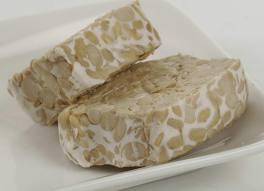Tempe is a traditional food of Indonesia, especially in a collection of Java. Tempeh-making technique has been known since before 1900, but still simple manufacturing procedure. Many of the basic ingredients that can be used in the manufacture of tempeh, but that much is known of soybean tempeh. To obtain good quality tempeh, the soybeans are used should also be of good quality and not mixed with other materials, such as corn, green beans and other grains. In addition, the processing procedure must be done properly.
Tempeh-making process is basically the process of tempeh mold spores grow, namely Rhizopus sp., In soybean seeds. In its growth, Rhizopus sp. forming threads called hyphae thread. This hyphal threads that bind one kedalai seeds with other seed, so that the soybean seeds form a compact mass. The mass of soybean was then called tempeh. During growth, the fungus Rhizopus sp. also produce enzymes that can describe the protein contained in soy beans, so that the proteins in soybean seeds is easily digested.
During the growth of the fungus Rhizopus sp. In addition to Rhizopus, estimated that many other possible types mkiroorganisme intervene, but did not show significant activity. However, the real activity of microorganisms
may intervene will look after the activities of the growth of Rhizopus sp. beyond the optimum period, ie after the formation of new spores which are white-black. It can be known, especially in Tempe, left or stored in room temperature, ie with terciumnya smell of ammonia. The presence of ammonia odor in Tempe showed that tempeh begins to decay. The smell of ammonia is still felt even tempeh have been cooked, so it can reduce consumer tastes. Therefore, in order to obtain good quality tempeh and hold a little longer, then during the process of making tempeh should be noted regarding sanitation and purity of seed (inoculum) to be used.
A. TOOLS AND MATERIALS
B. 1 TOOLS
1. Washbasins
2. Sieve
3. Cormorant
4. Fan
5. Cukil wood
6. Winnowing
7. Stove
8. Other necessary equipment
B. 2 MATERIALS
1. Soy beans
2. Tempeh or pure cultures of Rhizopus sp.
3. Plastic bags or banana leaves, or leaves of teak.
B. HOW TO WORK
1. Wash winnowing tray, sieve, and cukil fan that will be used, then dried.
2. Clean the soya beans from other materials are mixed, then rinse.
3. Soak kacangkedelai that has been washed for 12-18 hours with a water temperature of around 700C.
4. Remove the skin of soybean seeds, then wash or rinse with clean water.
5. Steamed or boiled soy beans until it feels soft.
6. After the soybean seeds feels soft, place the seeds on a winnowing tray has been cleaned, then kipasi while stirring-stirring until beans are warm.
7. Sprinkle yeast that had been prepared tempe little by little and stirred to evenly (1.5 grams of yeast to 2 kg of soybean tempeh).
8. prepare plastic bags or banana leaves or teak leaves for wrapping. When the plastic bags used for packaging, give small holes in the bag with menggunakanjarum.
9. Enter soybeans that have been given the yeast into the wrapper, set the appropriate thickness dengans elera.
10. Inkubasikan soybeans is at room temperature for one or two days or until the entire surface covered with mushroom soy.
